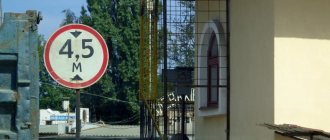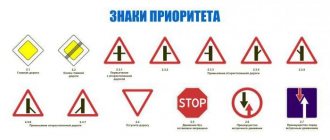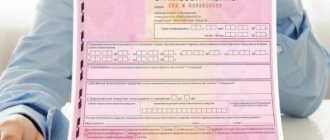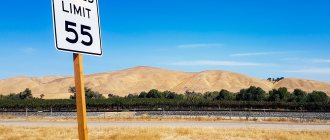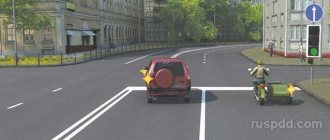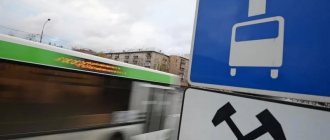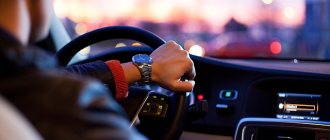- 1. What is the coverage area of the speed limit sign? 1.1. Effect of the “Maximum Speed Limit” sign with a coverage area sign
- 1.2. Effect of speed limit until end of limit zone signs
- 1.3. Effect of the “Speed Limit” sign to a new similar sign
- 1.4. Effect of the “Speed Limit” sign before an intersection or populated area
The validity zones of signs in the traffic rules for 2021 are regulated either by the Appendix to the traffic rules of the same name - road signs and markings, or by GOST R 52289-2004. In our case, the effect of a speed limit sign can be determined by the presence of an intersection, a sign indicating the length of the limit, as well as signs that remove such a limit, or the beginning or end of a populated area. But let's talk about everything in order!
What is the coverage area of a speed limit sign?
Sign 3.24 “Speed limit”
The “Speed Limit” sign is installed on dangerous sections of roads near sharp turns or concentrations of accidents, where it is dangerous to move at the initially permitted speed. In addition, sometimes a sign is installed where it is allowed to drive at a higher speed than required by the conditions of the city, highway or highway. For example, if in a city there is a speed limit sign of 80 km/h, then you can drive exactly up to 80 kilometers per hour, and not up to 60, as required by traffic rules in the city.
Also, according to GOST for 2021? You cannot limit the speed with such signs to more than 20 km/h. That is, if you are driving along a highway where the speed limit is 90 km/h, and along the way you come across a “Speed Limit” sign with the number 60, then such a sign is installed illegally - if you want to limit the speed to 60 kilometers per hour, then first there must be speed limit sign up to 70 or 80, and only then, after 100-150 meters sign 60 (clause 5.4.22 of GOST).
Just like any other prohibitory signs, the speed limit sign is not endless, even if there is no corresponding sign for the end of the limit. The priority of the conditions of the sign here is similar to the “No Stopping” sign, and let's look at all the conditions for limiting the areas of action.
Effect of the “Maximum Speed Limit” sign with a coverage area sign
Everything is simple here: immediately under the sign 3.24 on the same column there is a sign 8.2.1 (see figure below), the number on which indicates the coverage area from the sign until the restriction is lifted. If, for example, the sign says 40, and the sign says 150 m, then this means that for the next 150 meters we must drive at a speed of no more than 40 kilometers per hour.
By the way, it is 40, not 60 or 59 km/h, that is a violation, and there is a punishment for this violation. It is prohibited to drive at a speed above 40 - this is a violation, there is simply no punishment provided if the speed exceeded is less than 20 km/h. But in the event of an accident, for example, such an excess may not be taken into account in your favor.
Effect of speed limit until end of limit zone signs
If a sign is used without a sign with a speed limit zone, then after such a sign there may be a “End of speed limit zone” sign with a crossed out speed value on a white background (and not on white with a red frame, like a prohibitory sign). Then the prohibition of the speed limit sign no longer applies after the end of the limit, and we can drive at the maximum speed allowed for this section of the road (city or other populated area - 60 km/h, highway - 90 km/h, highway - 110 km/h) . The same maximum speed ban is lifted by the sign “End all restrictions” - an empty sign with diagonal strikeouts on a white background.
In addition, signs at the end of the coverage area of prohibiting traffic rules signs may be placed, including if the prohibition sign itself was standing with a coverage area sign. And this is logical, isn’t it, because we shouldn’t measure the distance indicated on the sign with a tape measure?!
Effect of the “Speed Limit” sign to a new similar sign
If after sign 3.24 a new sign with a different restriction value is installed, then the previous restriction does not apply, which is quite logical. Less logical is the situation when a new constraint sign sets a greater value for such a constraint. For example, there was a sign “60” and after it there was a sign “80”. Then a new restriction also applies, and the previous one is removed.
Effect of the “Speed Limit” sign before an intersection or populated area
If there are no signs under the speed limit sign and if there are no signs for the end of the speed limit or the removal of all restrictions of prohibition signs, then the speed limit prescribed by sign 3.24 is valid either until the nearest intersection or until the “Built-up area” or “End of built-up area” sign. What you see first along the way will cancel the effect of this prohibitory sign. Moreover, a roundabout intersection is also a full-fledged intersection.
At the same time, remember that not all intersections mean the end of the coverage area of the “Speed Limit” sign. Various kinds of secondary exits or junctions of dirt roads into forests, exits into fields and other minor roads not marked with a road junction warning sign (warning signs are installed 50-100 meters away in populated areas and 150-300 meters away on highways), then is one of these signs:
Remember also that exits from adjacent territories are not intersections according to the interpretation of traffic rules and therefore do not cancel the effect of the “Speed Limit” sign.
As for the end or, accordingly, the beginning of a populated area, this is not just a visible beginning or end, respectively, but their designation by one of the following information signs:
| The beginning of the settlement | End of a settlement |
Also keep in mind that the Residential Zone sign overrides the restriction. In general, a residential area rarely just begins with a road, but, most likely, you drive off the road to another, and the new one has its own rules. But even if you find yourself in a rare exception, when a restricted road moves into a residential area, then remember that the 2021 traffic regulations require a maximum speed of 20 kilometers per hour in a residential area.
How does the speed limit sign work in different situations?
- The effect of the “Speed Limit” sign until a new sign of the same type. In certain cases, after sign 3.24, a new sign is installed with a different value of the restriction. Then the previous restriction does not apply; it quite logically loses its force. It also happens that a new limit sign allows you to drive at a higher speed than the previous one. It looks strange, but a new restriction is also in effect, and the previous one is removed.
- The effect of the “Speed Limit” sign before an intersection or populated area. In the event that there are no signs under this sign and there are no signs for the end of the speed limit or the removal of all restrictions on prohibition signs, then the “Speed Limit” sign is valid until the nearest intersection, designation of a populated area or the end of a populated area. The first thing on the way will cancel the prohibitory sign. It is worth considering that a roundabout is also a full-fledged intersection. But not all intersections mean the end of the speed limit sign area. Secondary exits or junctions of dirt roads into forested areas, exits into fields and other minor signs that do not have road junction warning signs. Entrances from adjacent territories, in accordance with traffic rules, are not intersections and do not cancel the effect of the sign, which limits speed. Regarding a populated area, this is not just the beginning or the end, but their designation with information signs. In any case, the 2021 traffic rules allow a maximum speed in a residential area of 20 km/h.
- Scope of the temporary speed limit sign. Typically, when repairing roads or constructing structures in the vicinity of the road or in cases of temporary concentration of traffic on a section of the road, temporary speed limit signs are used. Unlike the usual one, the temporary sign is made on a yellow background instead of white. Speed limit signs with a yellow background have the same effect as regular ones. The end of the coverage area of a temporary sign, according to the traffic rules, also has no distinctive features from the coverage areas of a permanent restriction. In practice, in most cases, temporary signs o. Basically, temporary signs require a significant reduction in speed, so several specific signs are installed that gradually limit the speed. An important point is that automatic video recording of speeding cannot be used on those sections of the road where temporary signs are installed. Only a traffic police officer with a camera in his hands can simply record the speed. For violation, he has the right to issue a fine.
What is the coverage area of the temporary speed limit sign?
Temporary speed limit signs are usually placed during road repairs or construction of structures near this road and in other cases of temporary concentration of a dense flow of cars on a section of the road. A temporary prohibition sign, unlike a permanent one, is made on a yellow background instead of white.
Temporary sign 3.24 “Speed limit”
The end of the coverage area of a temporary “Speed Limit” sign, according to the Road Traffic Rules, is no different from similar areas of coverage of a permanent restriction - it can be canceled by the nearest intersection, the end/beginning of a populated area, the sign of the end of the speed limit or all restrictions, or the spreading distance, if installed with with the appropriate sign.
In practice, for 2021, most often there are temporary signs o, because a significant reduction in speed with temporary signs is required, which means that several such signs have been installed, gradually limiting the speed lower and lower.
Also keep in mind that automatic photo and video recording of speeding is not allowed in areas where temporary signs are installed. Simply put, speed violators cannot be caught on auto-fixation cameras if such speed is limited by a temporary sign. But an inspector with a camera in his hand, which simply records the speed of the car for subsequent proof of excess, can issue a fine if there was such a punishable excess.
Reducing the coverage area
In some cases, the duration of sign 3.24 is artificially shortened. To do this, use symbol 3.25 (“End of maximum speed limit zone”) or information plate 8.2.1. The latter indicates the length of the section of the path on which the ban is in effect.
By the way, it is in the case of a sign that many drivers get lost because they do not have time to measure the distance. Therefore, you should always pay attention to the accompanying symbols installed together with sign 3.24.
The object's coverage area is also reduced by installing a similar symbol with different numbers limiting the speed. For example, if you passed a sign prohibiting driving faster than 80 km/h, and then came alongside a sign that indicated the limit of 60 km/h, you should be guided by the second one. In this case, the first sign loses its force.
It is important to remember that the “Maximum Speed Limit” symbol is not used unreasonably. It is used on dangerous sections of roads where the risk of accidents is increased. Therefore, the requirements of such graphic objects cannot be neglected. You need to follow them not to avoid a fine, but to preserve your own life and health.
rudorogi.ru/
What does not cancel the coverage area of the “Speed Limit” sign?
So, above we looked at which road signs and intersections cancel the distribution of sign 3.24. Now, so that you are not mistaken, we will present what does not cancel the speed limit:
- pedestrian crossings;
- tunnels, bridges, overpasses;
- if the road turns without forming intersections (even though it turns in the opposite direction);
- the “Main Road” sign, if it is not installed in front of the intersection (according to GOST, this sign can be installed simply on a section of the road, prohibiting stopping according to traffic regulations);
- traffic lights, if they are installed not at an intersection, but, for example, to allow pedestrians to pass.
If the coverage area of the speed limit sign on the plate is greater than the distance to the intersection
If it suddenly turns out that the sign under the “Speed Limit” sign says “2 km”, but after one kilometer you find an intersection or the end/beginning of a populated area, then know that the latter cancel the effect of the sign prohibiting moving at a speed higher than the specified one on the sign. That is, an intersection or the beginning/end of a populated area in this case takes precedence over a sign. This is all because in this case, such an organization of the signs is contrary to GOST and means that the road workers placed the sign incorrectly. And GOST clearly states that the range of action on the sign cannot be greater than the distance to the intersection or the nearest populated area or its end.



